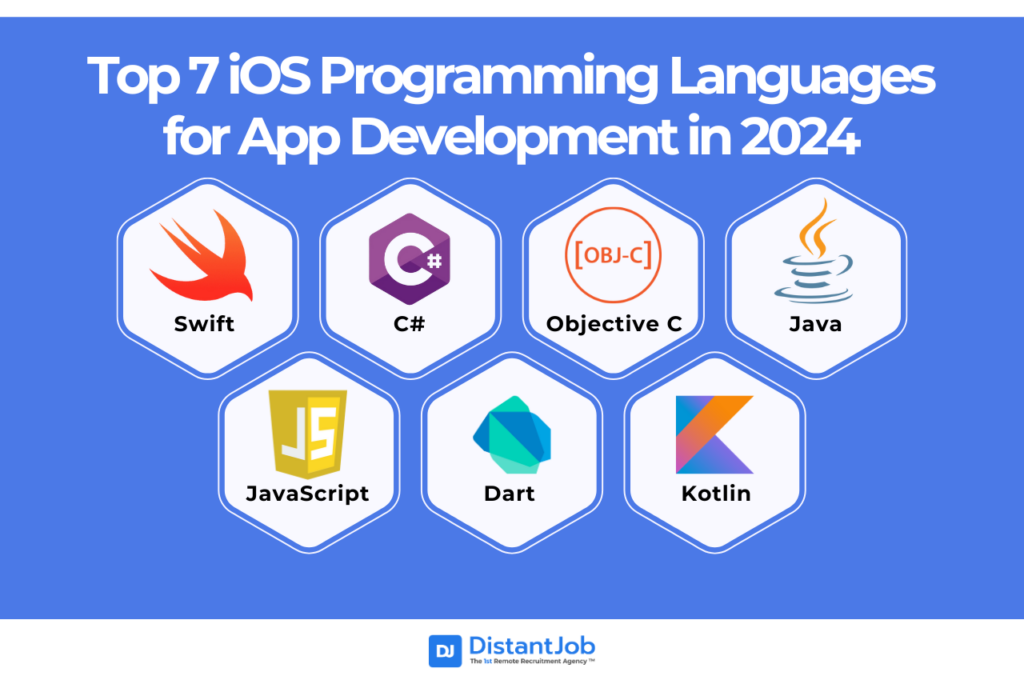The best iOS programming language is the one that matches your application’s requirements, your developer’s skills, and your budget for performance and maintenance. For pure-native power, choose Swift or Objective-C. For faster, cross-platform releases, consider React Native (JavaScript), Flutter (Dart), .NET MAUI (C#), Kotlin Multiplatform, or Java toolchains. Each option trades off speed, polish, and long-term maintenance:
- Swift is ideal for native performance and deep integration with Apple technologies.
- React Native is the perfect choice if your team prefers JavaScript and needs cross-platform support.
- Flutter is Best for consistent UI rendering and fast development cycles.
- .NET MAUI is recommended for seamless integration within Microsoft’s ecosystem.
- Kotlin Multiplatform is suited for flexible, shared business logic across platforms.
Developing an iOS app no longer requires you to strictly use native code, and over the years several iOS programming languages have surfaced. If you are also considering the iOS market for your next mobile app, then it’s a good idea to evaluate your options and see which is the best for your project.
In this article, we explore the top seven iOS mobile programming languages based on many criteria beyond the most popular. The goal is to help you choose the right language based on the software being developed and other criteria, such as the community and its strengths and cons.

In 2025, a few languages shine because of their unique strengths and adaptability to different developers’ needs. Whether you want to make apps just for iOS or apps that work on many platforms, these seven languages will give you what you need to do well in the changing world of iOS apps.
Let’s take a look at each language and see how it can help you create great iOS apps:
1. Swift – The Forefront of iOS Development
Swift is a programming language created by Apple to build apps for all their operating systems, including iOS, iPadOS, macOS, tvOS, and watchOS. When building native iOS apps, Swift remains the preferred choice in 2024.
Apple designed Swift for faster and easier development. Some of the frameworks that work seamlessly with Swift include Cocoa, CloudKit, and AVFoundation.
As of 2024, Swift ranks 20th on the Tiobe index, reflecting its continued relevance despite the rise of other languages.
Swift is the ideal choice for a wide range of iOS projects:
- Its capability in large-scale commercial projects is demonstrated by its use in popular applications like Lyft, LinkedIn, and Airbnb
- High-performance applications, including graphically intensive games, and complex image or video editing software.
- Applications that require deep integration with iOS hardware capabilities like advanced camera features, sensors, and platform-specific services.
- Projects where long-term maintainability, stability, and the ability to leverage the latest Apple innovations are paramount.
- Essentially, any new native iOS development project where cross-platform deployment is not the primary driver.
| Pros | Cons |
| Optimal Performance & Responsiveness: Direct compilation to native machine code ensures that Swift applications are fast, efficient, and provide a fluid user experience, | Limited to Apple Ecosystem: Swift is primarily designed for building applications for Apple platforms. |
| Access to Latest Apple Technologies: Swift developers gain immediate access to the newest features, APIs, and frameworks released by Apple | Limited community support compared to other languages like Python, Java, and C++ |
| Reduced Development Time (compared to Objective-C) | As a relatively modern language, Swift has undergone significant evolution. |
| Regular updates | Small talent pool |
| Wide scalability | |
| Enhanced Safety & Stability | |
| Automatic memory counting | |
| Swift is deeply integrated with Apple’s development tools, most notably Xcode. |
2. Objective-C – The Legacy Choice
Objective-C is an extension of the C programming language with object-oriented programming capabilities. Developed in the early 1980s, it was the primary language for creating OS X and iOS, plus their APIs. Though it can still be used for iOS applications, Objective-C has largely been replaced by Swift. While Swift has largely superseded it for new application development, Objective-C retains a degree of relevance, primarily for the maintenance and extension of a vast number of existing applications and for certain low-level system interactions.
As of 2024, Objective-C ranks 32nd on the Tiobe index.
The best use case for Objective C:
- The primary use case is the maintenance, bug fixing, and incremental extension of existing iOS applications that were originally written in Objective-C.
- It may be used in projects that require deep interaction with older C or C++ libraries where Swift’s interoperability features might present more complexity for particular edge cases.
- It remains relevant for supporting legacy iOS devices or targeting older versions of iOS SDKs where Swift compatibility might be a concern
Objective-C is an old and relatively outdated programming language (It was last updated in 2016). So, it’s best suited for maintaining older iOS apps that don’t support Swift. For modern iOS development, Swift is the better choice.
Facebook, WhatsApp, and Instagram were originally built with Objective- C.
| Pros | Cons |
| Stable and mature language | Outdated Syntax and Verbosity |
| Supports dynamic typing | Steeper learning curve compared to Swift |
| Proven track record for legacy apps | Limited pool of talent |
| Compatibility with C and C++ | Not open-source |
| Limited functionality | |
| Lack of new updates |
3. JavaScript – Bridging the Gap with React Native
JavaScript, in combination with HTML5 and CSS, is widely used to create web apps. For iOS development, JavaScript frameworks like React Native and Apache Cordova are used to “wrap” the app for native deployment.
A primary allure of React Native is the significant extent of code that can be reused across both iOS and Android platforms, reducing redundant development efforts.
Unlike some other cross-platform solutions that render their own UI elements, React Native translates its components into actual native UI widgets. This generally results in applications that have a look and feel consistent with platform conventions.
As of 2024, JavaScript ranks 6th on the Tiobe index.
Best use cases for JavaScript with React Native
- Content-driven applications such as news readers, blogs, and informational apps
- E-commerce applications, social media platforms, and utility apps.
- Projects with constrained budgets and aggressive timelines that need to launch on both iOS and Android relatively quickly.
You’ll want to use web technologies for your iOS app if you plan to develop, or already have, a web app that you want to port over to iOS.. When starting a project for a new app, since you need to ensure you have developers on your team that are well versed with HTML 5, CSS, and JavaScript because these three work together. This changes if you’re using React Native however, since you’ll only require JavaScript developers to deliver a hybrid application that can be published to other mobile platforms or even as a web app.
Apps like Facebook and Instagram use JavaScript frameworks for mobile app development.
| Pros | Cons |
| Wide pool of talent | Limited functionality |
| Multiplatform support | Performance issues with responsive design |
| Open source | Debugging Complexity |
| Code Reusability Beyond Mobile | Reliance on Native Bridges |
| It’s considered easy to pick up, especially for beginners. | Native Expertise Still Needed for Customization |
| Faster Development Cycles & Reduced Cost | |
| Allows creating offline apps |
4. Dart – Rising with Flutter
Flutter, developed by Google, uses Dart as its programming language to enable seamless cross-platform development. While Dart and Flutter may not have the same mass adoption as other languages, they offer an easy way to create fast, responsive, and visually appealing apps out of the box.
As of 2024, Dart ranks 30th on the Tiobe index.
Flutter provides a rich set of pre-designed, highly customizable widgets, enabling developers to create visually appealing, brand-consistent, and complex user interfaces with smooth animations and transitions. Developers can write code once in Dart and deploy it on iOS, Android, and increasingly, web and desktop platforms, maximizing code reuse and development efficiency
Best use cases for Dart
- Applications that require highly branded, custom user interfaces with intricate animations and a strong emphasis on visual design.
- Startups and projects focused on developing MVPs that need to launch quickly on both iOS and Android to test market hypotheses.
- Applications where maintaining a consistent look and feel across all platforms is a high priority for the brand
- Flutter has been used to build prominent applications such as Google Pay, eBay Motors, Groupon, and the Abbey Road Studios Topline app
The best use case for Dart is when you want to develop an iOS app alongside a web app version. If you’re interested in adopting Google’s material design philosophy, Flutter comes with it set up from the start.
The Google Ads app is a notable example of a mobile application built with Dart and Flutter.
| Pros | Cons |
| Dart is easy to learn for individuals with a background in JavaScript or Java. | Few libraries to aid development |
| Multiplatform support | Limited talent pool |
| Open source | Relative smaller community |
| Easily create appealing visuals for your app | Flutter applications can sometimes have larger file sizes than true native apps or even some React Native apps. |
| Provides a wide collection of widgets to customize your app | Limited Native API Access |
| Beautiful, Consistent UIs | Still Evolving Framework |
| Allows creating offline apps |
5. C# with.NET MAUI (Evolution of Xamarin)
C# is a cross-platform, object-oriented programming language created by Microsoft in 2000. However, it wasn’t considered a programming language for iOS apps until Xamarin came along. Xamarin is a hybrid app development framework built on C# that allows teams to share a majority of the code between apps for different target platforms, thus streamlining their development and support.
.NET Multi-platform App UI (.NET MAUI) represents the evolution of Xamarin.Forms. It is a cross-platform framework that allows developers to build native applications for iOS, Android, Windows, and macOS using C# and XAML, all integrated within the broader.NET ecosystem.
NET MAUI allows developers to leverage the full power of the.NET platform, the C# language, and the XAML markup language for UI definition. This includes access to a vast array of.NET libraries and tools
As of 2024, C# ranks 5th on the Tiobe index, reflecting its continued growth in popularity.
The best use case for C#:
- Enterprise-grade cross-platform applications, particularly for organizations that are already heavily invested in the Microsoft technology stack (e.g., using Azure, SQL Server, other.NET services).
- Projects where the development team possesses strong existing skills in C# and.NET.Applications that need to share a significant amount of code across mobile platforms (iOS, Android) and Windows desktop environments.
It is best to use C# if you plan to build iOS and Android applications. It is also ideal if your team already has C# developers. Popular apps like Slack and Pinterest have utilized C# with Xamarin for their mobile apps.
| Pros | Cons |
| Great community support since it is a popular and mature language | Relatively steep learning curve for beginners |
| Open-source | Limited flexibility since it is based on the Microsoft.NET framework |
| High performance | Larger App Size |
| It has a huge library | Potential Performance Issues |
| Cross-platform support | Xamarin to.NET MAUI Migration |
| Easy to use | |
| Strong for Enterprise Applications | |
| Productivity for.NET Shops | |
| Scalable and updateable |
6. Java – The Cross-Platform Contender
Java is a general-purpose, class-based, and object-oriented programming language created in 1995. It remains one of the most popular and mature programming languages, with over 9 million developers currently using it worldwide.
Since it is a general-purpose programming language, it can be used to build iOS and Android applications. One of Java’s essential aspects is that its code doesn’t need recompilation to run on any platform, making it an incredibly reliable and fast cross-platform programming language.Much like C#, Java requires a framework to port the code to something that iOS understands. There are many, with one of the most popular being Codename One.
As of 2024, Java ranks 4th on the Tiobe index.
Best use cases for Java:
Java is not a very popular language for iOS. Despite the existence of hybrid app development platforms such as Codename One, it is only ideal to use it if you already have an Android application that you would like to build for iOS with minimal effort. If you are strictly building an iOS app, it is best to opt for Swift instead.
Popular apps like Spotify use Java in their development process.
| Pros | Cons |
| Cross-platform language | High memory use |
| Large community support | Relatively hard to learn for those with no programming background |
| Scalable and updatable programming language | Performance slower than native iOS languages |
| Huge pool of talent | Type-heavy language |
| Open-source | |
| Flexible | |
| Secure |
7. Kotlin – Bridging iOS and Android with Kotlin Multiplatform
Kotlin is widely known for Android development, but with Kotlin Multiplatform, developers can now use shared code between iOS and Android apps. This allows developers to use common business logic across platforms while still writing native UIs for each.
Kotlin provides good interoperability with Swift and Objective-C on the iOS side, facilitating communication between the shared Kotlin module and the native Swift code.
One major advancement to the KMP ecosystem is that the iOS side of Compose Multiplatform has reached a stable version. While KMP is mostly about sharing logic with native UIs, with JetBrains’s Compose Multiplatform, you can now share the UI itself using Kotlin. This means that software companies can now create software using the same UI system with the same programming language for IOS, Android, and the desktop, and it is finally considered stable. This makes KMP a much more complete solution. It gives companies the option to choose, based on their priorities, whether to share only the logic or the UI as well.
Best use cases for Kotlin:
- Development teams that want to maximize code reuse for complex business logic, data layers, and networking, while retaining completely native UIs to ensure the best possible performance and adherence to platform-specific UX conventions.
- Projects with intricate business rules or algorithms that need to behave identically across iOS and Android.
- Gradual modernization of existing native applications by migrating specific parts or modules to a shared KMP Kotlin module.
- Kotlin Multiplatform is ideal for apps requiring native UIs on iOS and Android, especially for enterprise applications.
Apps like Netflix and Trello use Kotlin for their cross-platform logic.
| Pros | Cons |
| Cross-platform development with native performance | Complex setup for iOS |
| Team Flexibility and Specialization | Learning Curve |
| Full Access to Native APIs | Smaller Community (Specifically for KMP) |
| Seamless integration with Android apps | Smaller ecosystem compared to native iOS development or well-established cross-platform tools like Flutter |
| Improved Stability | Setup Complexity |
| Large, active community |
Comparison Table of Top iOS Languages
Choosing the right stack ultimately hinges on two axes: what kind of user experience you must deliver and what strengths your team already owns. Native Swift wins when every animation must feel pure-iOS; otherwise, cross-platform options like React Native, Flutter, .NET MAUI, Kotlin Multiplatform, or Java toolchains trade a bit of polish for faster multi-platform delivery and better leverage of current talent.
This side-by-side chart evaluates all the top current IOS development languages and frameworks based on each individual use case.
| Language | Primary Language | UI Layer | Performance & UX | Code-Sharing Scope | Maturity / Ecosystem | Best Fit When… | Main Drawbacks |
|---|---|---|---|---|---|---|---|
| Swift (Native) | Swift | SwiftUI / UIKit | ★★★★★ (direct, zero bridge) | None – iOS only | High (Apple’s focus) | Need flawless iOS feel & bleeding-edge APIs | Separate Android build doubles effort & cost |
| Objective-C (Native) | Objective-C | UIKit (often mixed with Swift) | ★★★★★ | None – iOS only | Legacy-strong (since 2008) | Maintaining/extending large Obj-C codebases; C/C++ interop | Declining mind-share; verbose syntax; fewer modern features |
| React Native | JavaScript / TypeScript | Native widgets via JS ↔ Native bridge | ★★★★☆ (bridge can bottleneck) | Logic + some UI (≈ 70 %) | Mature (huge JS talent pool) | Team strong in React/web; quick 2-platform launch | Bridge complexity; heavy 3rd-party reliance |
| Flutter | Dart | Custom widgets (Skia) | ★★★★☆ (smooth, consistent) | Logic + UI (≈ 90 %) | Mature (vibrant plugin store) | Identical branded UI across iOS/Android; rich motion | Non-native look; larger binary; team must learn Dart |
| .NET MAUI | C# | Native controls wrapped by .NET | ★★★★☆ (AOT; small runtime tax) | Logic + UI (≈ 80 %) | Growing (inherits Xamarin) | Microsoft-centric orgs; reuse C# for desktop/web | Runtime overhead; fewer iOS-specific libs |
| Kotlin Multiplatform (+ Compose MP) | Kotlin | Shared Compose UI or native SwiftUI | ★★★★☆ (no bridge) | Logic 100 % + optional UI | Emerging / strong (stable 2023-25) | Kotlin-savvy teams; need granular sharing | Smaller iOS talent pool; tooling still maturing |
| Java (third-party toolchains) | Java | Varies—native UI via Codename One, Gluon, J2ObjC | ★★★☆☆ (extra runtime / translation) | Logic + (optional) UI (≈ 70-90 %) | Niche but active | Huge existing Java codebase you want to reuse | Not first-class on iOS; smaller plugin ecosystem; extra tooling layer |
What to Consider Before Building an iOS App?
1. Know Your Target Market
Before you build your iOS app, it is essential to have details of the people you target to use the app. Having details of the target audience and how they usually use their devices will give you an idea of how to design the app and which features matter most to these people.
Knowing your target audience will also make it easier for you to run ad campaigns for the app because you know exactly who you are communicating to. So, start by doing market research to determine your target users based on gender, age, location, and any other relevant criteria.
2. Know The Problem You Are Solving
While planning to build your iOS application, you need to have a clear idea of the problem you are trying to solve. This should always be the first step because if your app is not solving any problem in the market, it will not be used by anyone. This will also help you determine if you have competitors.
3. The Scope Of Your Application
After defining the purpose of the app, you now need to determine the different capabilities your application will have. For instance, if you are building a fitness application, you need to determine the exercises to include in the app. You can always expand the scope of the app in the future, but initially, it’s best to set a strong foundation in terms of what you’ll cover at the start.
4. What Devices To Support
Apple has been making iPhones since 2007, so you need to decide which of these iPhones your app will support. Your app’s functionality will help you determine the iOS devices with the necessary database to run it. Knowing the devices capable of running your app will help you determine the iOS versions to build the app for and also which languages you can use to write the app itself.
5. Evaluate Your Capacity To Build The App
Building an application is no easy task and will require several people with different development skills. So, before you start writing your first line of code, it is crucial to evaluate if you have the necessary talent to build the kind of app you want.
Some of the specialists you may need on the team include; Frontend and backend Developers, UX Designer, UI Designer, Graphic Designer, and even QA developers and Project Manager.
For startups, you can have one developer play two or three of the above roles. However, eventually, you may consider hiring remote developers who can help you scale your application.
Future Trends in iOS App Development
The iOS development landscape is dynamic, evolving with technological advancements, changes in user expectations, and shifts in the strategic directions of platform providers. From evolving cross-platform capabilities to advancements in AI and machine learning, developers are increasingly leveraging these new technologies to build more innovative, efficient, and user-friendly apps.
Here’s what’s likely to happen:
SwiftUI’s Growing Popularity
Apple’s SwiftUI framework is becoming the preferred choice for creating iOS apps. It allows developers to write less code and build more flexible user interfaces. As more people start using Swift, we’ll see an increase in developers turning to SwiftUI. This trend will help them create apps that work across different devices, from iPhones to Apple Watches.
AI and Machine Learning Become Key
As apps focus more on giving users personalized experiences, it’s becoming crucial to include Core ML (Apple’s machine learning tool) in iOS apps. By 2026, we can expect to see AI-powered features become common in iOS app development. These will include things like predictive texts, smart recommendations, and facial recognition.
Rise of Cross-Platform Development
Flutter and React Native help developers create apps that work well on iOS and Android. As companies seek to reduce costs and time-to-market, expect these cross-platform tools to gain even more traction, especially with the support of languages like Dart and JavaScript.
Focus on AR/VR and 3D Experiences
Apple invests in augmented reality (AR) through ARKit so iOS apps will keep pushing the limits of immersive user experiences. AR/VR features will benefit retail, education, and gaming apps changing how users interact with digital content.
Kotlin’s Growing Influence
Kotlin Multiplatform’s development has an impact on cross-platform development. It now allows developers to share business logic between iOS and Android. While its ecosystem is still smaller than React Native or Flutter, it’s on the rise and is particularly appealing to Android-first developers expanding into iOS.
Final Thoughts
We’ve introduced you to seven popular languages you can choose from if you want to build your next iOS application. As you venture into your development journey, having the right resources at your fingertips is invaluable. Online documentation is a free and accessible asset. You can find official docs for Swift and Objective-C on Apple’s developer site, Java on Oracle’s site, JavaScript on MDN Web Docs, and Dart on its official site. For community discussions and additional resources, GitHub and Stack Overflow are excellent platforms. Equip yourself with these resources to navigate through the intricacies of iOS app development and make informed decisions for your projects.
No matter what language you decide going forward, you’ll most likely need to hire people for your development team. And that’s where we come in!
DistantJob can help you hire expert iOS app developers (or hire any other kind of developer!) to bolster your dev team. We have 10+ years of experience and can get you the candidates you need in as short as 2 weeks. We take our job very seriously: hiring people with the right skills is important, but so is having someone that fits your company culture. DistantJob prides itself on finding the right people that will want to work for you.
Interested? Don’t hesitate and contact us or visit our office at Montreal!





